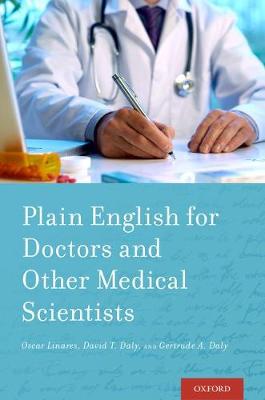(To see other currencies, click on price)
MORE ABOUT THIS BOOK
Main description:
Plain English for Doctors shows how to write about medical science in a clear and vivid way. It can help a medical writer at any level, from beginner to veteran, since it gives specific, practical advice. Writing in plain English can help your writing reach a wider audience, including people in other specialties, levels of training, other fields, and other countries around the world.
What makes medical writing hard to read? Is it complex science or complex grammar? This book shows how to keep good science but avoid complex grammar. It describes the symptoms of medicus incomprehensibilis, those over-used writing habits that tend to make medical writing hard to read. It shows how to treat each symptom using a proven plain English writing tip. Each tip is easy to apply and comes with exercises. The exercises are based on excerpts from articles published in leading medical
journals. Model revisions vastly improve reading ease and grade level.
The book looks at medical writing from three angles. Concept 1, Take charge of your reading ease score, shows how to manage reading ease. Concept 2, Write vividly, shows how to write more vividly by focusing on real world objects and actions. Concept 3, Present logical reasoning clearly, gives tips on how to choose a clear narrative pathway and forge a strong chain of logical reasoning.
This book is a must for anyone who writes about medical science. The ability to express complex ideas in simple language is not a remedial skill. Rather, it can only be seen as a sign of mastery.
Contents:
Table of Contents
Preface
Introduction
a. Why bother to write in plain English?
b. What do we mean by plain English?
c. Medicus incomprehensibilis
d. Using the tips in your writing
e. Notes on the exercises
Concept 1 - Take charge of your reading ease score
a. Flesch reading ease & Flesch-Kincaid grade level tests
b. WSEG scores - How we track key reading ease data
1. Use normal sentence length
a. Keep sentence length 15 words average, 25 words maximum
b. Keep the subject and verb close together in the first seven or eight words
c. Put the main point first. Then give commentary, detail or support
2. Prefer the short word
a. Keep essential scientific terms; minimize other long words
b. Cite a common medical term once to avoid confusion
c. Write a compound word to promote reading ease and show how you pronounce it
d. Omit any unnecessary word ending
e. Avoid the noun string
f. Don't be afraid to start a sentence with "and" or "but"
g. Avoid using a high percentage of long words
3. Omit any needless word
a. Spot and omit needless words
b. Omit the needless "of"
c. Omit the needless "that"
Concept 2 - Use vivid language
4. Prefer active voice
a. Identify active and passive voice
b. Revise passive into active voice
c. When should you use active voice?
d. Minimize forms of the verbs "to be" and "to have"
e. Identify nominalization
f. Convert nominalization into a verb in active voice
5. Prefer concrete language
a. Identify abstract and concrete subjects
b. Revise abstract into concrete
c. Use nouns & verbs to carry the weight of meaning
d. Write in the singular
e. Talk in terms of one doctor treating one patient
6. Observe the 1066 principle
a. Prefer the short word to describe the real world
b. Prefer "-'s" to show real-world possession or connection
c. Use terms consistently; avoid elegant variation
d. Avoid using a long, Latin word to describe the real-world
7. Statistical analysis of WSEG scores for exercises in Chapters 1-6
Concept 3 - Present logical reasoning clearly
8. Organize your narrative in a way that's helpful for your reader
a. Introduce and develop a single idea in each paragraphs
b. Present two-dimensional data in a table, chart, or graph
9. Choose a clear narrative pathway
a. Start with things known
b. Start by anchoring the discussion in the real world
b. Choose a good narrative pathway
c. Make a smooth transition between concrete and abstract
10. Forge a strong chain of logical reasoning
a. Explain each step of reasoning
b. State the problem before you solve it
c. State the problem in words before you state it in symbols
Afterword: Can things ever change?
Appendices
1. English users around the world
2. Selected excerpts from medical science articles
3. Exercise key
Glossary
References
PRODUCT DETAILS
Publisher: Oxford University Press (Oxford University Press Inc)
Publication date: May, 2017
Pages: 224
Dimensions: 156.00 x 234.00 x 13.00
Weight: 400g
Availability: Available
Subcategories: General Issues, General Practice, Medical Study and Teaching Aids

